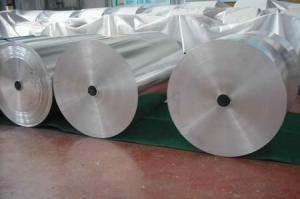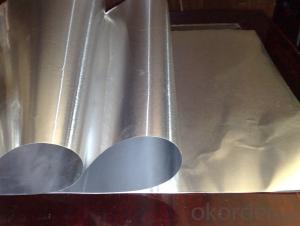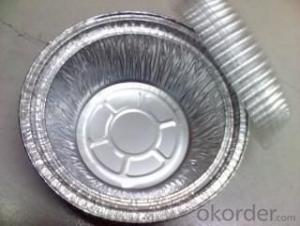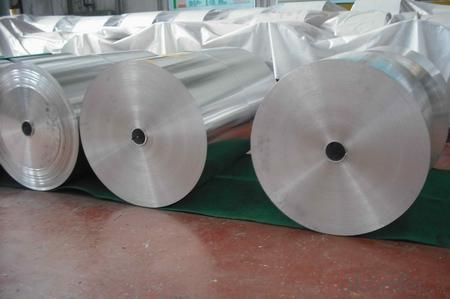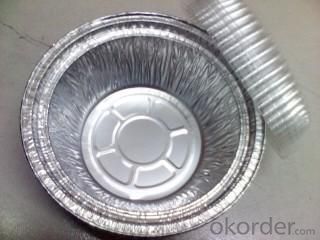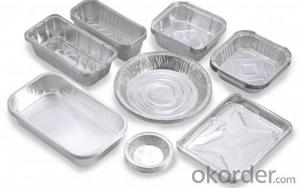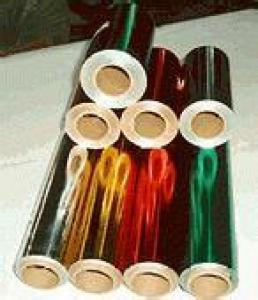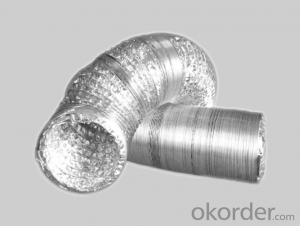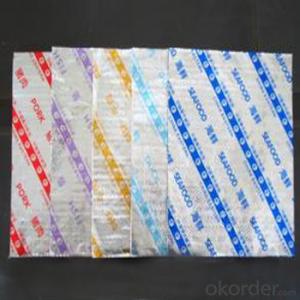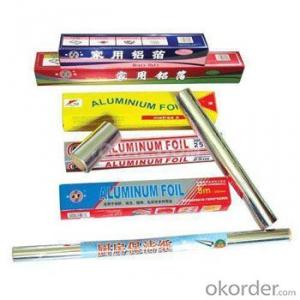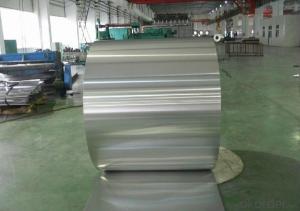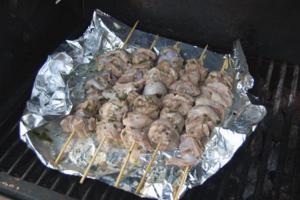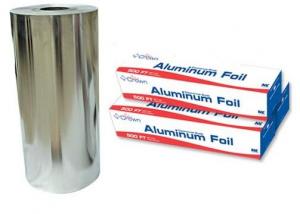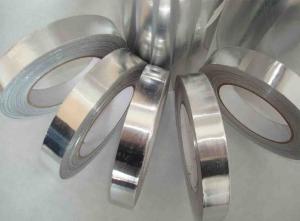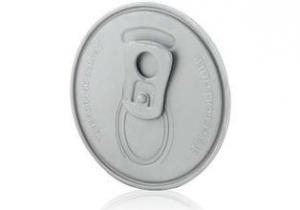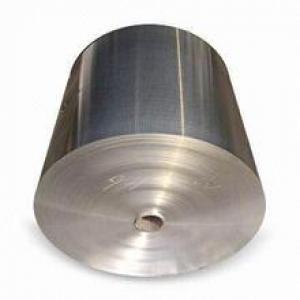Wegmans Aluminum Foil - Household Foil for Everyday Use
- Loading Port:
- Shanghai
- Payment Terms:
- TT OR LC
- Min Order Qty:
- 3 m.t.
- Supply Capability:
- 200 m.t./month
OKorder Service Pledge
OKorder Financial Service
You Might Also Like
1.Description
Aluminium foil (or aluminum foil) is aluminium prepared in thin metal leaves with a thickness less than 0.2 millimetres (8 mils); thinner gauges down to 6 micrometres (0.24 mils) are also commonly used.In the United States, foils are commonly gauged in thousandths of an inch or mils. Standard household foil is typically 0.016 mm (0.63 mils) thick, and heavy duty household foil is typically 0.024 mm (0.94 mils). Thefoil is pliable, and can be readily bent or wrapped around objects. Thin foils are fragile and are sometimeslaminated to other materials such as plastics or paper to make them more useful. Aluminium foil supplantedtin foil in the mid 20th century.
Annual production of aluminium foil was approximately 800,000 tonnes (880,000 tons) in Europe and 600,000 tonnes (660,000 tons) in the U.S. in 2003. Approximately 75% of aluminium foil is used for packaging offoods, cosmetics, and chemical products, and 25% used for industrial applications (e.g. thermal insulation, cables and electronics).
In North America, aluminium foil is known as aluminum foil. It was popularized by Reynolds Metals, the leading manufacturer in North America. In the United Kingdom and United States it is, informally, widely called tin foil, for historical reasons (similar to how aluminum cans are often still called "tin cans").Metallised films are sometimes mistaken for aluminium foil, but are actually polymer films coated with a thin layer of aluminium. In Australia, aluminium foil is widely called alfoil.
2.Why do you choose us?
Our quality is best!
3.Specification and application
Household Foil Household Foils Using ALUMINIUM
Application: Household packages
Alloy: 8011/ 1235
Temper: 0.009mm-0.04mm (±6%)
Width: 200mm-720mm
Mechanical Properties: Tensile Strength (U.T.S)≥ 50Mpa, Elongation≥ 1%
Standard: GB/ T3198 / ASTM-B209/EN 546
Special specification is available on customer's requirement
SURFACE QUALITY: GOOD APPEARANCE WITH NO-CRACK AND WELL-DISTRIBUTE GRAIN.
BUILD UP: TIGHT SLIT EDGES FREE FROM CRACKS, LAYER TO LAYER SHIFT NOT MORE THAN 2MM.
PROFILE: -0/+1%
FLATNESS: MILL FLATNESS COIL HAVING EDGE WAVINESS RATHER THAN CENTER BUCKLES SHALL BE ACCEPTABLE.
ROLLING PERFORMANCE: RE-ROLLABLE TO THE FINAL DESIRES GAUGES
4.Pictures
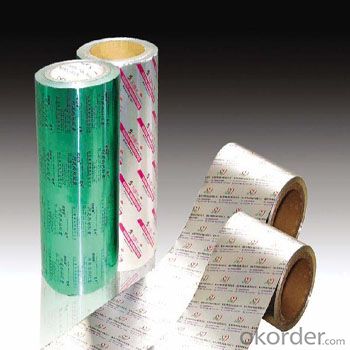

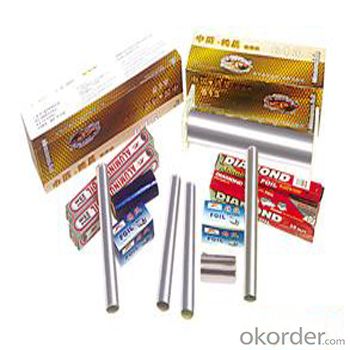

5.FAQ
1)what is aluminum?
Aluminium (or aluminum; see spelling differences) is a chemical element in the boron group with symbol Al and atomic number 13. It is a silvery white, soft, nonmagnetic, ductile metal. Aluminium is the third most abundant element (after oxygen and silicon), and the most abundant metal in the Earth's crust. It makes up about 8% by weight of the Earth's solid surface.
Aluminium metal is so chemically reactive that native specimens are rare and limited to extreme reducing environments. Instead, it is found combined in over 270 different minerals.The chief ore of aluminium is bauxite.
2)What's kind of payment term we can supply?
CIF,CFR, FOB and other.
3)Can we supply samples?
Yes, we can!
4)What can you do if you have other quastions?
You can contact us freely at any time!
- Q: Hard cheeses do they last forever? Is it a food that lasts for a long, long time?
- In some states it would cost 4G just to get the permits for a bridgeYou better also own the property on both sidesIf we're talking about a true river (1/2 mile wide), then you're up the creekYou'll need another million or two (bare minimum) just to start planning it and hiring an engineer and architect If you're talking about something small like a brook, then (to build something extremely crude) you'll need a couple of I-beams for pylons, and that'll probably wipe out your budget right thereIf we're talking an extremely small brook (less than 10 feet), then just lay a dozen rust-resistant I-beams across it, and you might be good to go I wouldn't drive a 4 ton truck across it, thoughMore like a one-ton geo metro at most.
- Q: When driving back from post office i noticed a rear clanking noise that sounds like you are dragging an aluminum can on a rope2002 honda civic with 113k miles.
- stand while styling your hair and putting on makeup
- Q: I used to keep celery in a big Ziploc bag and it would go bad fairly rapidlyNow I wrap it in aluminum foil and it seems to stay crisp much longerAny ideas why?
- no because i tried it my self.
- Q: i found a site that sells makit bakit priducts and i found one of the kits had earrings but it was only one pair and i wanted a couple different onesif anyone knows where i can buy makit bakit earring kits or earring wires and makit bakit charm frames i would really appriciate itthanks in advanced
- Try Head and shoulders! It actually helps seriously because it gets rid of dandruff and in the process helps your scalp which in turn helps your hair! Get the hydrating kind! I hope I helped!
- Q: I just bought brachs carmel candiesdo you melt them on a stoveDo you add evaporated milk? HELP HELP HELP!!!!!!!!!!!!!!!!!!!!!!!!!!!!!!!!!!!!!!!!!!!!!!!!!!!
- 6 Granny Smith apples 6 wooden sticks 1 (14 ounce) package individually wrapped caramels, unwrapped 2 tablespoons water 1/2 teaspoon vanilla extract Insert wooden sticks 3/4 of the way into the stem end of each applePlace apples on a cookie sheet covered with lightly greased aluminum foilCombine caramels and water in a saucepan over low heatCook, stirring often, until caramel melts and is smoothDip each apple into the caramel and gently run apples around insides of saucepan to scrape off some of the caramelScrape excess caramel from the apple bottoms using the side of the saucepanPlace on the aluminum foil and chill until ready to serve.
- Q: I know that 7075 is lighter and stiffer, but is there a difference in comfort?
- i use chi 44 iron guardit works really good and it smells nice )
- Q: Does the lewis dot structure for Aluminum Oxide (Al2O3) look like this:OAl-O-AlO? If not, then how does it look?Also, could you help me make a lewis dot structure for Carbon Dioxide, Calcium Oxide, Diphosphorous Pentoxide, and Diiodine PentoxideI don't get this at all reallyI don't know how to tell whether or not it's ionic or convalentThanks for your help.
- drink 8 cups of water a day
- Q: I am interested in trying some new foods this holiday season and I also try to prepare my foods as healthy as possibleI have never had pheasant before and was wondering if it is possible to cook it in my small rotisserieI was thinking I could pick up a small, maybe 9 lbs pheasant and cook it on my rotissierieMany recepies call for bacon or pork but I try to avoid those foods if possibleDoes anyone have any suggestions? What should I put on the bird before I start cooking? When I rotisserie my chickens I usually just rub on some mojo and rub a little salt insideHow might that work for a pheasant? I have heard the birds tend to be dry, so I am hoping the rotisserie will keep it juicyAll suggestions welcomeI am also thinking about trying a duck and or goose alsoIf anyone has any suggestions on that they are welcome alsoI basically just want to try a few new meats and look for alternatives to my chicken I cook over and over
- Pheasant is an extremely dry proteinYou MUST add fatI have only cooked it twiceThe first time was a disaster because I treated it like chickenIt tuned out to be shoe leatherThe second time I cooked it I brined it over night in a sea salt water mixture I added chopped onions, celery, bell pepper and garlic to the brineNo vinegar and no sugarRemove the bird from the brine and toss the brineI dried my bird and stuffed the cavity with savories - onions, garlic, celery, peppers, mushrooms (porcini mushrooms reconstituted in dry red wine - strained through a coffee filter - wine reserved for gravy) I did not attempt to grill my bird - much too dry and toughCook until crisp 3 strips of thin slice bacon in a heavy skillet or even better a heavy roaster (you don't have to change pots) Remove bacon - reduce heat - saute onions, celery, peppers until onions are translucentRemove savories from panSeason your bird inside and out with sea salt and fresh ground pepperBrown in bacon drippingsPut bird in a roasting panPour pan drippings and reserved wine over birdAdd savories and mushroomsLay strips of thin slice bacon over breast of birdTent aluminum foil over the breast and cook at 350 until the legs can be moved with no resistance and juice is clear not redI have to tell you that pheasant is not one of my favorite dishes to cookI have 1 left in the freezer - not sure how I will use itI am thinking of making some kind of meat pie with itI am an excellent home chef and I am really not satisfied with the result of my cooking techniques for pheasantI am thinking that just barely grilling the breast may be a good optionHave to use bacon or larding stripsIf you come up with an awesome recipe for this difficult bird please share itRemember the spirit of ThanksgivingGive thanks for family and friends, the bounty of your table, the privilege of living in this wonderful country, our freedom to be who we are, and don't forget - God bless the cook(s).
Send your message to us
Wegmans Aluminum Foil - Household Foil for Everyday Use
- Loading Port:
- Shanghai
- Payment Terms:
- TT OR LC
- Min Order Qty:
- 3 m.t.
- Supply Capability:
- 200 m.t./month
OKorder Service Pledge
OKorder Financial Service
Similar products
Hot products
Hot Searches
Related keywords
